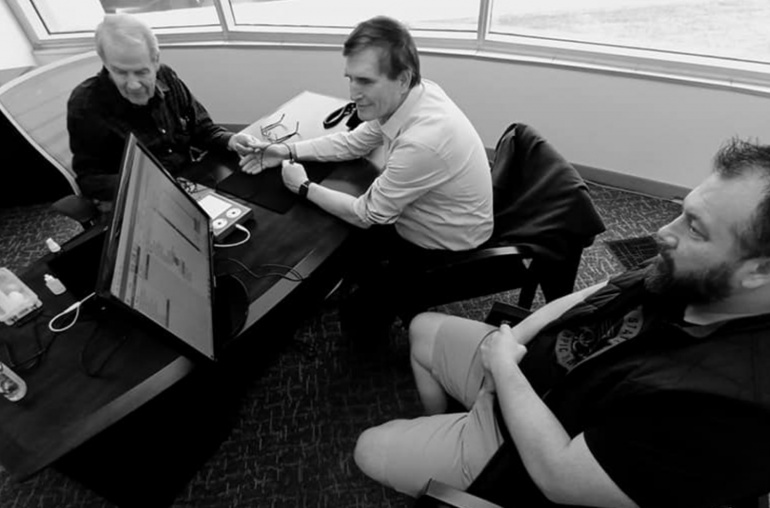Dr. Curtin has spent a lifetime in medical sciences developing new technologies in micro-robotics, ultrasound, and spectroscopics and how they affect the body on a cellular level. As a physicist he studied the efficacy of laser instruments and developed a process controller for a large scale oxygen system. Much of his life’s work has been directed at how the endocrine and nervous systems operate and communicate. This is a three-part series of interviews with Dr. Curtin, a fascinating dive into how our bodies modulate on the cellular level, and how we can understand what affects those decisions.
TC: Our bodies are talking to us all the time. Can we go deeper than just knowing we hurt? Or that we’re not feeling well?
R: Our body is extremely complicated. It has trillions of cells to manage, and it has to do that in real time. You could ask, “why don’t we know what’s going on?” and the reason is, we don’t want to know what’s going on. We don’t want microsecond reports on the calcium level of our toe.
TC: That would be data overload.
R: Yes. It appears that we have an internal and external consciousness. To make decisions you have to have a control or feedback system. And you have to have an intention for what you would like that intention to be.
TC: So I am aware that I am walking down the street, and my intention is to not get hit by a car, so I am aware of the traffic next to me and where I can safely walk.
R: Yes. Our bodies are constantly monitoring to some desired condition. Blood pressure, heart rate, breathing rate, brainwaves, everything. When we stop managing that system, it decays. So life itself is dependent on intelligent control down to the cellular level. Every cell has to make decisions—what DNA to express, what to build with the RNA it expresses, and when to quit. Life itself is the expression of intelligence, and intelligence is the ability to make choices.
TC: Sounds like a lot is going on without us knowing it.
R: Well, in order to manage anything that complex we need a collection of habits, learned behaviors that we keep doing over and over again without a lot of consideration for changing them, unless they stop working. Take allergies for example. That’s the body’s reaction to a stimulus. The reaction used to work, but now doesn’t. But the body is in the habit of reacting that way.
TC: So an unhealthy reaction to something like pollen?
R. We need to note the difference between a reactive behavior and a response behavior. A response behavior is you determining what the appropriate response to a stimulus is. A reactive behavior is simply a reaction to a stimulus.
TC: A learned behavior.
R: Yes. Our body is running on a learned set of behaviors because those habits have served it well so far. So we come to this self-evident realization that each of us has a very powerful intelligence that is working hard to maintain our body. In order to do that it has to be aware of what it needs to do. The question is “can some of that internal awareness be passed on to our consciousness so we can better support it?”
TC: So what would those lines of communication look like?
R: We don’t know, we just know it has to be there. We know we have a neurological system that is collecting information. So we focus on the brain, but that may not be the only way. For example, we also have a hormonal system that may also invoke a state of fear, or hunger, or happiness. And each of those changes the basic environment of our body and our external awareness of that feeling. So we know we have at least those two systems: the nervous system and the endocrine system, but we don’t know that that’s all of them.
TC: So is there an external stimulus that affects an internal reaction?
R: Sure. Let’s look at an example. You’re walking along in the woods and you see a grizzly bear. That’s an external stimulus that gets interpreted as a vital threat to the whole person. And so you say: Feet do your stuff! It changes the entire internal chemistry of your body. Physiological decisions are being made internally at a cellular level at an organ level and at a total body level.
TC: So that’s a healthy response, running away from a Grizzly bear. What does it look like when things go wrong?
R: We have these things called diseases, or maladaptive behaviors. Things that are not according to the book. We live in a toxic environment. We live among other organisms that have their own agenda that can invade our body and cause problems. And we have an immune system that has its own set of intelligent feedback that is constantly looking for those things and trying to protect the body.
TC: So back to the question: Can we communicate with the body to better understand what’s going on and what it needs?
R: Normally we try to infer what’s going on by doing imaging of the body, x-rays or MRIs to see if there is something physically distorted or out of shape—a broken bone or a tumor. We can also do chemical analysis: a blood sample to see if the chemistry in your body is similar to a collection of samples from a lot of other people we consider healthy or unhealthy. We can also do tests on blood flow and the nervous system. So a lot of things we can see or measure. What we can’t do very well is determine if what we measure is appropriate or inappropriate in many cases. Take hormones, they are changing all the time. So it’s hard to get the right read, we’re left to make a statistical assumption—comparing you to a collection of measurements in a pool with other people.
TC: Sounds like we’re still not good at communicating with a particular individuals needs, we’re relying on statistics rather than talking directly to the body.
R: Here’s what I have spent my entire career exploring: “Is it possible to take a man-made computer and communicate with this supercomputer you were born with? The only way to know is to treat the body as a communication system like a telephone. I have to provide a stimulus and see if I get a response back. The way to test this is to put in a series of stimulation signals, which I call queries, and see if you get a reasonable pattern of response that is appropriate for the questions. Before the telephone we had the telegraph, so we got back a series of dots and dashes. That’s where we are now, not quite to the full conversation you get with a phone. Think of a polygraph and how it measures the body’s response to questions that are stressful and non stressful. In order to do that the operator must first set a baseline for truth then ask yes or no questions and then measure the stress reactions against the truth baseline.
So we had to find some kind of observable indication, a response to yes or no questions. And the next step was to develop a whole series of these questions based on a medical canon. Let’s go back to allergies. So with a series of questions of whether or not your body is allergic to a substance, we can measure the stress responses, same as in a polygraph test, and by process of elimination determine which substance is most likely causing the allergic reaction.
TC: And this same kind of query protocol works on more than just allergies?
R: Yes it does.
ClearCo = Check out ThinkClearly
ThinkClearly = Subscribe to our newsletter





